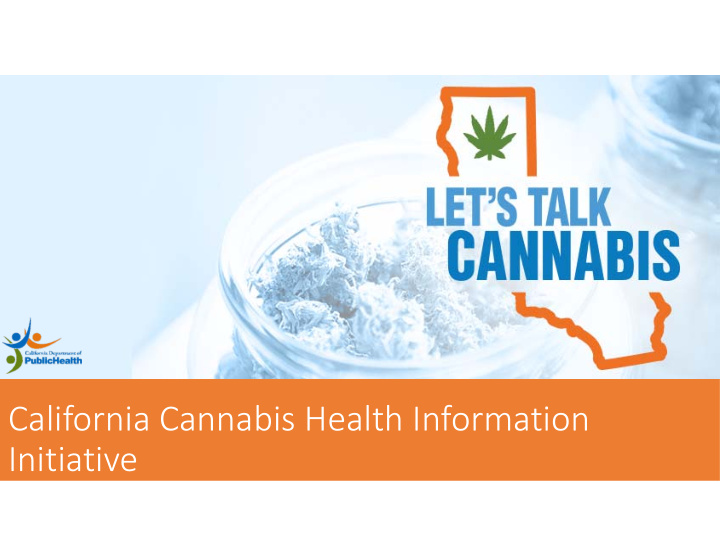



California Cannabis Health Information Initiative
Cannabis Public Health Surveillance System: What Medical and Public Health Impacts to Monitor? Risk and Protective Factors Consumption Consequences and Outcomes Social norms (attitudes, beliefs, Self‐reported use Poisoning injuries perceptions) Sales Physical health Marketing Child welfare Fatalities Number and location of retail outlets Education Criminal justice Motor vehicle traffic injuries Mental health disorders Substance use, abuse, treatment, and recovery Other Potential Indicators • Potential positive impacts • Environmental impacts (pos/neg) • Social justice Conceptual framework adapted from SAMSHA’s Strategic Prevention Framework: a • Economics comprehensive process to address substance use and related (medical, public • Drug Seizures health and behavioral) health issues. • Production/Manufacturing Toxicity
Existing Data Sources: Population‐Based Surveys Youth Adult Users Pregnancy and Parents Breastfeeding Youth Risk Behavior National Survey on Drug Maternal and Infant Survey Use and Health (NSDUH) Health Assessment (YRBS) (MIHA) Behavioral Risk Factor California Student Tobacco Surveillance System Survey (CSTS) (BRFSS) California Healthy Kids California Adult Tobacco Survey (CHKS) Survey (CATS)
Past Month Cannabis Use among Californians 12 or Older (National Survey on Drug Use and Health, Substance Abuse and Mental Health Services Administration) Cannabis use in the Past Month Among those Cannabis use in the Past Month Among those Aged 12 or older, California, 2010‐2015. Aged 12 or older, California, 2012‐2014. 25 20 Percent 15 10 5 0 2010 2011 2012 2013 2014 2015 Year 12‐17 years 18‐25 years 26+ years
Past Month Cannabis Use Among Adults 18 and over in California, 2016 (Behavioral Risk Factor Surveillance Survey)** Total 18‐20 years 21+ years % % (95% CI) % (95% CI) (95% CI) Cannabis use in past month 10.5% (9.1, 11.9) 20.0% (11.1, 28.8) 9.8% (8.5, 11.2) Number of days used cannabis in the past month 1 or 2 days 27.4% (20.5, 34.4) 16.7% (7.2, 26.2) 28.8% (21.3, 36.4) 3 to 9 days 15.8% (11.6, 20.0) 25.4% (17.2, 33.5) 14.5% (10.7, 18.3) 10 to 19 days 13.2% (8.4, 18.1) 11.2% (0, 25.3) 13.5% (8.3, 18.7) 20 or more days 43.5% (36.5, 50.6) 46.7% (26.2, 67.2) 43.1% (35.9, 50.4) **Preliminary results
Past Month Cannabis Use Among 7 th , 9 th , and 11 th Graders in California, 2003‐2013 (California Healthy Kids Survey, California Department of Education/WestEd) 30 25 20 Percent 15 10 5 0 2003‐2004 2005‐2006 2007‐2008 2009‐2010 2011‐2013 2013‐2015 Grade 7 3.9 4.7 6.6 5.9 6.6 5.0 Grade 9 12.4 12.6 15.4 13.6 14.9 13.4 Grade 11 19.8 19.2 23.9 24.2 24.3 20.1
Self‐Reported Use of Cannabis During Pregnancy 2016 Maternal and Infant Health Assessment (Provisional) 15 marijuana use during pregnancy (95% Percent of women reporting 10 California CI) 4.2% 5 10.5 5.7 3.7 5.2 4.7 2.5 0 Black White Hispanic 15‐19 20‐34 35 years or years years older Race/Ethnicity Age Source: Provisional 2016 Maternal and Infant Health Assessment (MIHA) Data. Provisional MIHA estimates are weighted to preliminary California birth certificate data and will differ slightly from MIHA estimates weighted to the final 2016 Birth Statistical Master File.
Phase I • Scientific Literature Review • “Let’s Talk Cannabis” branding • Website • Fact Sheets • Formative Research
Phase I Formative Research Reasons for Cannabis Use
Phase 2 • Extensive Formative Research • Develop key messages for target populations • Creative materials • Social media and digital advertising • Resources for Local Health Jurisdictions
Youth, young adults (18‐25), pregnant & breastfeeding Social normalization Edibles, concentration, dosing Public Health Variety of products/methods Issues Driving/Co‐use Long term effects/lack of research Clean Indoor Air laws
Recommend
More recommend